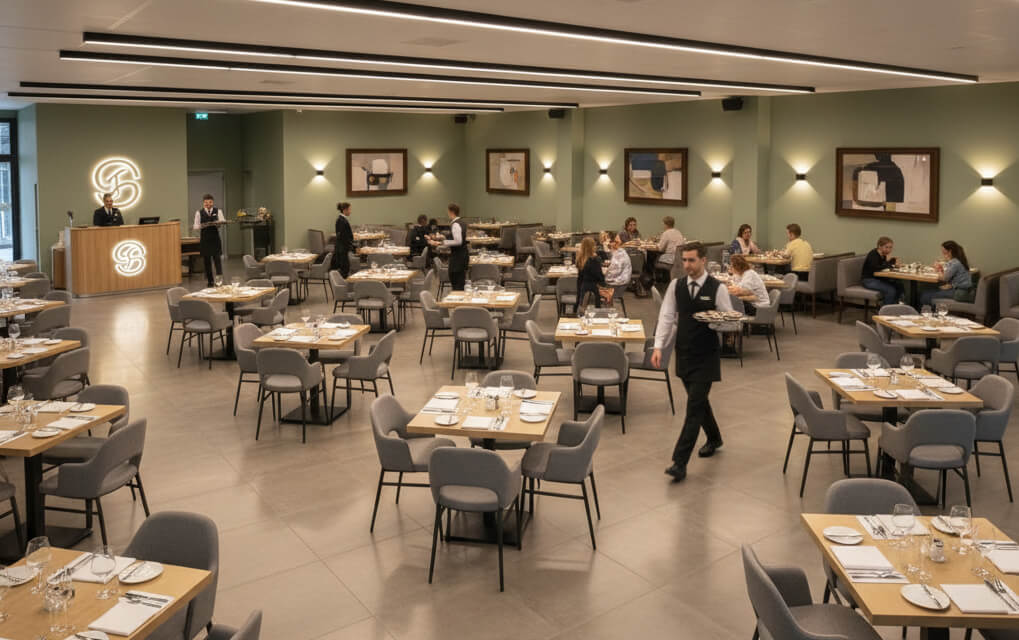October 13, 2025

In the world of restaurants, layout is much more than a design choice — it’s a science. The distance between tables can have a huge impact on everything from guest comfort and staff efficiency to overall revenue. Getting table spacing right is crucial in providing an optimal dining experience, and it can even influence how diners perceive your brand. Let's dive into why table spacing matters and how it can make or break your restaurant's success.
In the world of restaurants, layout isn’t just about aesthetics — it’s a science. The distance between tables can have a huge impact on everything from guest comfort and staff efficiency to overall revenue. Getting table spacing right is crucial in providing an optimal dining experience, and it can even influence how diners perceive your brand. Let's dive into why table spacing matters and how it can make or break your restaurant's success.
A well-planned dining room layout plays a critical role in your restaurant's overall success. While cramming in too many tables may increase seating capacity, it often creates a cramped, chaotic atmosphere that can make diners feel uncomfortable. On the flip side, too much space between tables may seem wasteful and reduce seating capacity, limiting potential revenue.
The ideal distance between tables strikes a balance between privacy, accessibility, and service efficiency. Studies show that when guests feel comfortable and have enough space to relax, they tend to linger longer, order more food or drinks, and generally have a better experience. This directly impacts your bottom line.
To plan your optimal layout, you can use digital tools like restaurant layout planners to visualize how different table arrangements might affect your space, comfort, and seating capacity. This can help you avoid costly physical renovations while ensuring the layout meets both guest needs and operational demands.
Resources:
Table spacing doesn’t just affect how the space looks — it significantly impacts the atmosphere of your restaurant. When guests have enough room to move freely, the dining environment becomes more relaxing. They can enjoy their meal without feeling cramped or overhearing every conversation around them, which contributes to a more positive experience.
A well-spaced dining area also encourages privacy, allowing guests to have more intimate meals while still being part of the overall restaurant vibe. In turn, this can enhance their perception of your restaurant, potentially leading to better reviews and stronger brand loyalty.
For example, with the rise of subscription-based dining programs, where repeat guests pay for access to exclusive dining experiences, consistent comfort becomes even more important. As explored in Why More Restaurants Are Going Subscription-Based, a reliable, comfortable dining experience is one of the key factors that drives repeat visits from these customers.
Additionally, accessibility should be a priority. Tables need to be arranged in a way that allows guests with wheelchairs, strollers, or other mobility aids to move freely through the space without disturbing others. Making these accommodations not only ensures a welcoming environment but also boosts online reviews, which in turn can improve your restaurant’s local search visibility. For tips on improving your website's SEO and review management, see Common Restaurant Website Mistakes and How to Fix Them.
Resources:
The right table spacing doesn’t only affect the guest experience — it also has a direct impact on your staff’s ability to perform efficiently. In a busy restaurant, servers need to be able to move quickly between tables to take orders, deliver food, and manage requests without getting in each other's way.
When tables are spaced appropriately, servers can navigate the dining area more efficiently, reducing wait times and increasing guest satisfaction. This becomes especially important when paired with smart kitchen technology like kitchen display systems or order management tools that streamline food preparation and delivery. Together, these elements create a seamless dining experience, from the kitchen to the table, even during peak hours.
Optimizing table spacing can also reduce the risk of mistakes, like orders being forgotten or mixed up. When waitstaff have clear sightlines to all of their tables, they can manage multiple orders with greater accuracy, leading to a more efficient service.
Resources:
For restaurants, especially those with limited space, it’s important to balance seating capacity with comfort. The temptation to pack in as many tables as possible to maximize revenue is strong, but it can have long-term consequences. Overstuffing tables might generate a quick profit, but it can create a negative dining experience, hurting your reputation and leading to lower customer retention.
By integrating insights from small restaurant online ordering strategies, owners can better predict peak periods and adjust their layouts accordingly. For instance, during busier times, flexible table arrangements can accommodate larger parties without feeling overcrowded. By analyzing customer flow and demand patterns, restaurants can adjust seating layouts seasonally or as needed to optimize both comfort and occupancy.
Resources:
Here are some practical tips for designing an optimal restaurant layout that balances both comfort and efficiency:
Resources:
By thoughtfully considering your restaurant's table spacing, you can create a dining experience that’s both enjoyable for guests and efficient for staff — all while boosting your restaurant’s overall performance.
Stay up to date with the latest tips, expert insights, product reviews, and step-by-step guides to help you grow, create, and succeed—no matter your industry or passion.